
Hop-forward styles remain top of mind for many breweries around the country. But it’s also good to take a moment and remember that hops aren’t the only ingredients going into a beer (and that they’re not impervious to Mother Nature with both the United States and Europe taking crop hits last year thanks to a combination of storms and unseasonable temperatures). In fact, even niche styles such as smoothie beers are continuing to gain popularity.
We’re not just going on anecdotal data here. For example, the style “Fruited – Sour” finished as the fourth most-checked in category on Untappd in 2021 with just over three million check-ins.
Starting out in eighth position in 2019, moving up to sixth in 2020, and ranking fourth in 2021, these whimsical American ales notched their best position ever on the Top Styles list.
Today, brewers craft all kinds of versions featuring a cornucopia of different fruits—such as peaches or raspberries—or age them in a variety of barrels—such as wine or mezcal.
Or even go a little crazy, turning them into a niche branch of the style now considered a smoothie beer or pastry sour.
A unique style that has skyrocketed breweries to Instagram fame and sent fans clamoring for new releases.
(Above photography courtesy of Oakshire Brewing)
What We’ll Cover in This Piece:
Affordable, Industry-Leading Brewery Software
What Is a Smoothie Beer?

Photography courtesy of Oakshire Brewing
Smoothie beers or pastry sours are essentially fruited kettle sours that have evolved with the benefit of brewers’ imaginations and creative ingredients.
“I would say [smoothie beers] are a gateway sour,” says Paul Grenier, CEO of Mortalis Brewing Company, which has spent the last few years experimenting with smoothie beers. So much so that ten of their smoothie beers rank in the top thirty all-time highest-rated smoothie beers on Untappd. “We don’t go for that enamel-stripping pH, instant heartburn, coming in super hot [sour],” he says. “We tend to structure our fruited sours like gateway sours that are approachable to everyone.”
And smoothie beers fall into that category perfectly.
Essentially, smoothie beers use a sour beer base, add fruits, sometimes lactose (although that’s debatable depending on who you talk to), and other adjuncts to try and recreate a certain fruit flavor profile or popular dessert or baked goods in liquid form.
The origin of this style probably starts back in 2015, when Philadelphia’s Tired Hands Brewing and Stockholm’s Omnipollo invented the milkshake IPA style. A hazy IPA with an addition of large amounts of lactose (milk sugar), vanilla beans, fruit purees, and other spices, milkshake IPAs are probably the progenitor of the smoothie beer.
After Tired Hands and Omnipollo’s revolutionary release, these types of sweet, heavily fruited beers rose in popularity across the U.S. Over time, brewers naturally evolved from using a New England-style IPA as the base to kettle-fruited sours.
The DNA of a smoothie beer starts with one unflappable thing—boatloads of unfermented fruit puree.
“Honestly, the biggest one no matter what you do with other crazy adjuncts is that all the fruit is unfermented,” says Dan Russo, director of brewing operations at Oregon-based Oakshire Brewing, which has earned region-wide recognition for the between forty to forty-five smoothie beers they’ve brewed in the last few years. “That’s the only way you’ll get the true texture of a smoothie sour. Can you make something that looks and tastes like a smoothie from Jamba Juice?”
The goal of a smoothie beer is to make it drink like its namesake, a smoothie—thick and fruited.
From there, you literally have a ceaseless bounty of produce, spices, and adjuncts to add.
The endless creativity makes these beers attractive to both consumers and brewers.
And breweries from coast to coast such as Mortalis and Oakshire have made a serious name for themselves perfecting the smoothie beer style.
Contrastingly, it’s also that “sky’s the limit” mentality that can make smoothie beers so tricky to brew.
Just because ingredients sound or look good together on paper doesn’t mean they’ll actually work in the brewhouse.
For that reason, there are many considerations to keep in mind when brewing a smoothie beer.
How to Build a Recipe for a Smoothie Beer
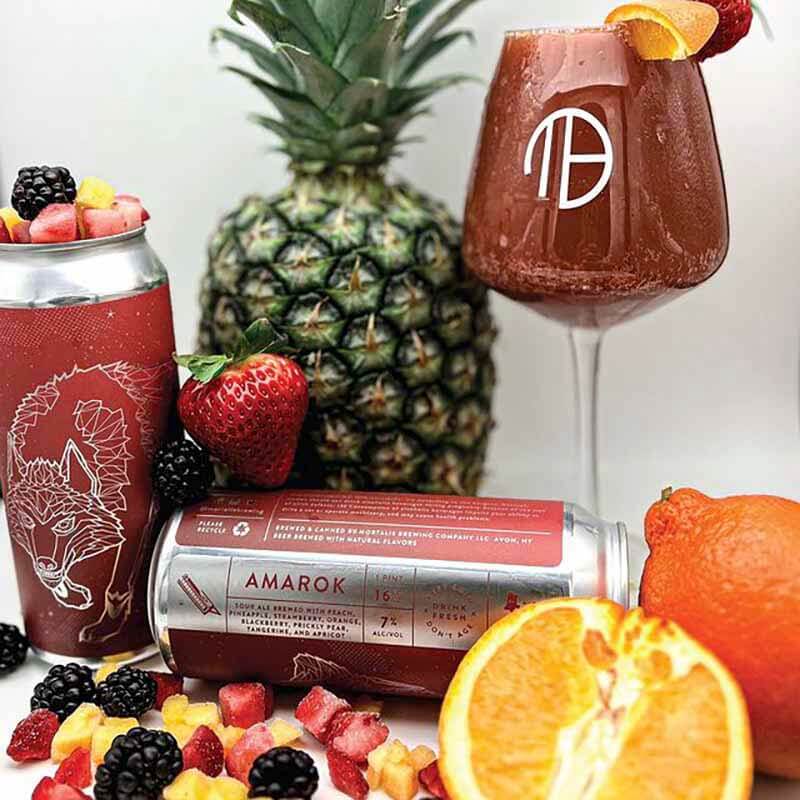
Photography courtesy of Mortalis Brewing Company
First and foremost, smoothie beers start with recipe creation.
Grenier likens this process to a scene from the popular animated Pixar film “Ratatouille,” about a rat named Remy who also happens to be an incredible chef.
“There is one scene in ‘Ratatouille’ where Remy is seeing flavors and pulling them out of the air to create a recipe,” says Grenier. “It is very similar for us because we are trying to grab certain fruits and mimic a potential dessert.”
For instance, if Mortalis is going after a popular breakfast item, they might try to recreate “berries and cream.” Or if they’re working on a beer in their popular Hydra series, which always features a pairing of three fruits, they’ll try to nail down that combination first.
“First and foremost is finding the right fruit combination… What pairs well with a raspberry? What’s going to pair well with a peach? What’s going to pair well with apricots?” says Grenier. “Once we have the fruit combination down we can say, ‘Is there any way we can expand on this, is there any way we can turn this into something potentially greater than the sum of the whole?’”
For example, if they’re working with a base of raspberry, blackberry, and blueberry—which everyone already knows works well together—how can they elevate that classic combination?
“Pair that with marshmallow to balance a bit of that raspberry acidity with that creamy, sweet marshmallow,” says Grenier. “Now you have a more balanced, approachable profile.”
Oakshire takes a similar approach with its Theme From the Bottom series that gets an injection of marshmallow creme and vanilla bean but really starts with the fruits.
“What are good fruit combinations? What do people get excited about? Has anyone ever done a passion fruit-pomegranate mix?” says Russo. “If you can find a recipe from one of those stay-at-home moms that has a blog…saying passion fruit and pomegranate is their go-to, here is a good chance it’s going to be awesome.”
At times, Grenier admits that the fruit combination might be strong enough that they don’t need to add any other adjuncts. “The earthiness of papaya, the bright citrus of pineapple, the smooth characteristics of peaches all play with each other really well, so if it’s that good we’ll leave it,” Grenier points out, before he can’t stop himself adding, “But would coconut enhance this maybe!?”
You can see how the recipe creation can get out of hand pretty quickly.
The word to remember here: balance.
The First Step to Brew a Smoothie Beer
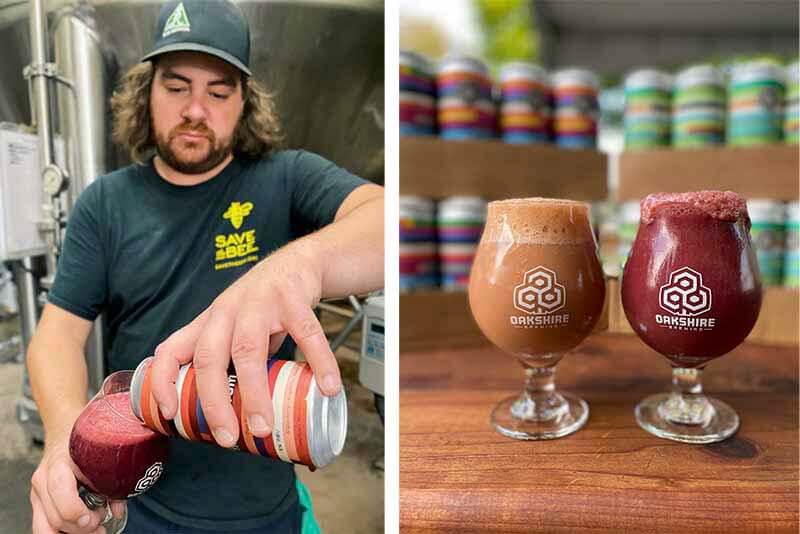
Photography courtesy of Oakshire Brewing
Brewing a smoothie beer starts way before you ever set foot in your brewhouse.
According to Grenier, “Once you find that winning combo, the next step or the best advice I can give is understanding those fruits and their acidity.”
When you’re brewing a kettle sour you have the ability to “kill” your lactobacillus in order to reach the pH you want in the beer. “But did you remember to take into account the acidity the fruit is going to bring?” says Grenier.
At Mortalis, they learned that lesson early.
“We had these really tart raspberries that were super awesome, so we pulled it out at 3.2 pH and then blended it and, oh my god, it was way too acidic,” recounts Grenier. “I didn’t think about how acidic raspberries could be.”
Once you have all of your flavor profiles worked out, make sure to account for that extra acidity in the fruits. “Maybe you don’t need to go quite so low on the pH,” says Grenier. “Try to figure out a happy medium.”
Russo recommends a baseline to shoot for with your sour base—3.4-3.5 pH. “We shoot for over 3.4 pH just to make sure that when you add acid back we have a balance and it doesn’t get too sour.”
Balance is key in a smoothie beer.
For instance, Russo says that people hit him up all the time for advice on making a key lime pie beer. “I tell them there is no way you can use one hundred percent key lime because key lime is one of the most tart things in the world,” he says. “If you try to do that on top of a sour beer you’re going to make a beer that is completely undrinkable.” (Which is also why he recommends staying away from one hundred percent lemon puree.)
Instead, he says the best way to create a recipe while keeping balance in mind is to think about what other flavors a key lime pie can offer. For example, Oakshire ended up brewing a beer with key lime and then sweet and sour cherries. “You’re trying to find flavor combinations that, even if they’re extreme, will balance everything,” says Russo. “It’s always about finding harmonious balance.”
Overall, he recommends starting with your desired flavor profile and how you want it to be received and then building the recipe backwards.
Which means…
You Will Experiment A LOT With a Smoothie Beer
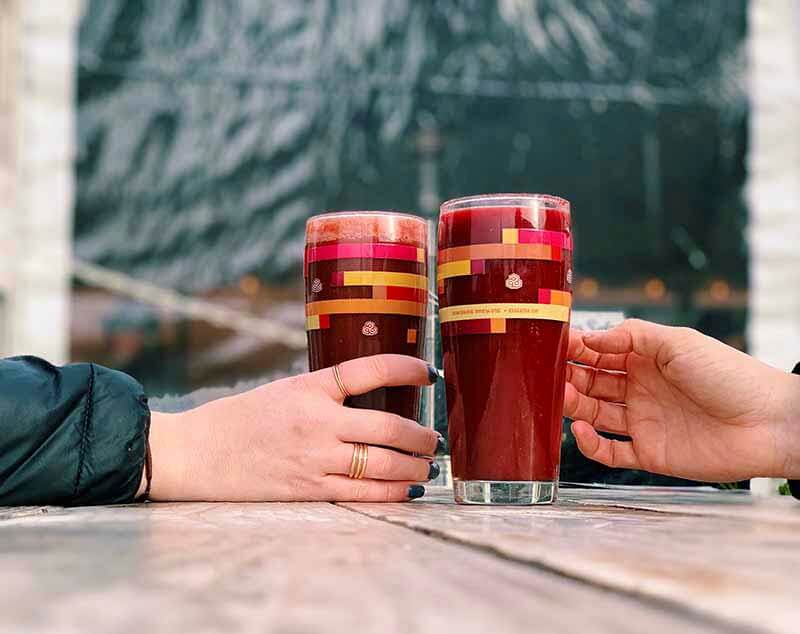
Photography courtesy of Oakshire Brewing
The nature of this style leads to a lot of necessary experimentation.
Mortalis went through a ton of trial and error early on to dial in their approach and figure out the best pH based on certain fruit types.
The best advice Grenier can give here is two-fold.
First, he recommends doing small pilot batches with your intended recipe, “break it off and fruit it in different ways to expand upon and see if you strike a eureka moment,” he says.
Second, he says that you should go out and try the versions of smoothie beers from all your friends in the industry. “Wow, why is their raspberry combo so much better than ours?” he says, noting that when he did this it was often how that brewery accounted for pH. “Figure out the tricks of the trade through friends and lots of trial and error to get the pH right.”
The Four Other Considerations About Fruit in a Smoothie Beer
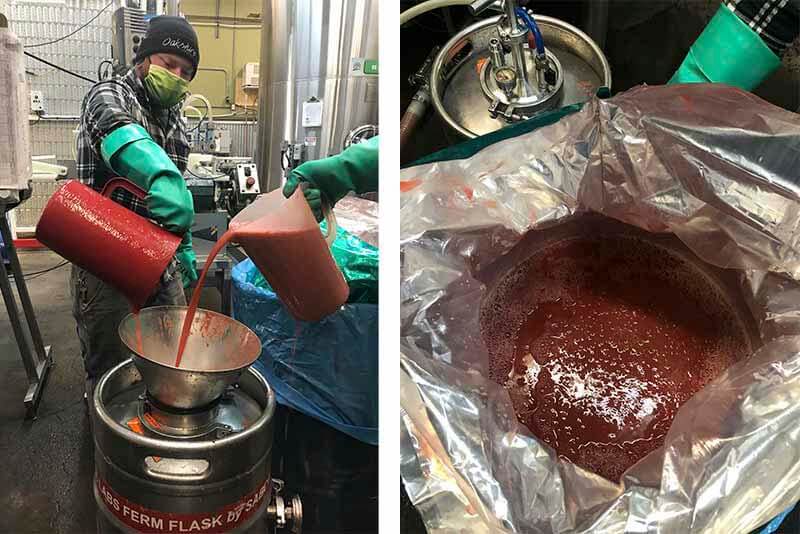
Photography courtesy of Oakshire Brewing
Beyond accounting for the acidity in the fruit and adjusting your pH accordingly, there are a few other considerations to keep in mind when it comes to working with fruit in a smoothie beer.
Fruit Selection
Do you go to hop selection in Yakima to pick your lots for the year? Probably. And why? Because it’s invaluable to go straight to the source to rub, smell, and find the hops with the best characteristics for your beers.
Why wouldn’t you do the same for the fruits you’re using in your smoothie beers? This ingredient is just as important.
“While other people were doing a lot of hop selections years ago, we were doing fruit selections,” says Grenier, who notes Mortalis now has twelve different valued fruit suppliers they partner with from around the country.
Now, when the brewery looks for a specific type of raspberry, they have three or four amazing ones to choose from.
“One tastes like Fruit Roll-Ups, the other one is more traditional with more acid to it, and this one over here is a blend they might have put some blackberries in, we think,” explains Grenier.
Actually, Grenier credits this approach for Mortalis’ success with smoothie beers. “That’s what helps us standout from a lot of other folks doing it because we’re taking the time to curate a list of fruits, to hand select that raspberry, to work with producers to help them…hone that process when making purees.”
The Best Fruit Form to Use in Smoothie Beers
Grenier mentioned something important in that last quote: purees.
Fruit comes in many, many forms—whole, juice concentrate, frozen, puree, etc.
How do you choose which version to use while brewing a smoothie beer?
While Grenier says they’ve tried many forms, “generally ninety-five percent of what we use is aseptic puree.”
The biggest and most important reason being that, “if you’re looking to make [the beer] shelf stable, it absolutely has to be aseptic or you have to pasteurize the beer after it’s created,” says Grenier. “This will help you avoid weird bacteria growth or weird off flavors.”
Grenier says that fresh fruit has a time and place, but it’s generally more difficult to work with and in that case pasteurization becomes almost essential.
Mortalis has worked with frozen fruit in a pinch (they have a frozen kiwi supplier Grenier raved about) and juice concentrate on a limited basis (apparently Grenier found a Maine blueberry juice concentrate that’s off the charts), but across the board the brewery favors working with aseptic fruit purees.
On the other hand, while Oakshire originally only worked with aseptic fruit purees, they found the options limiting after a while.
“Everyone is looking for a new flavor… What’s the cool thing you’re doing? What’s the weirdness?” says Russo.
Looking to expand their flavors by using juice concentrates, Oakshire started pasteurizing its smoothie beers in May of 2021.
The extra step kills off any additional brewer’s yeast (see below for more information on pasteurization), opening up a brewery’s fruit roster to non-aseptic products like juice concentrates.
The advantages, Russo says, are that you can find some pretty weird, funky flavors. Such as an organic concord grape, which he wants to use to make a peanut butter jelly beer.
If you do end up using concentrate, there are two big considerations.
First, you absolutely need to find a way to pasteurize your smoothie sour to avoid refermentation in the can (otherwise, because of the added sugar in concentrates, you can end up with what Russo calls “can bombs.”)
Second, you’ll probably need to blend a concentrate back with at least some puree.
“There is not enough sustenance without having puree,” says Russo. “You can do weird flavors but you just need to blend them with a puree to get that smoothie thickness.”
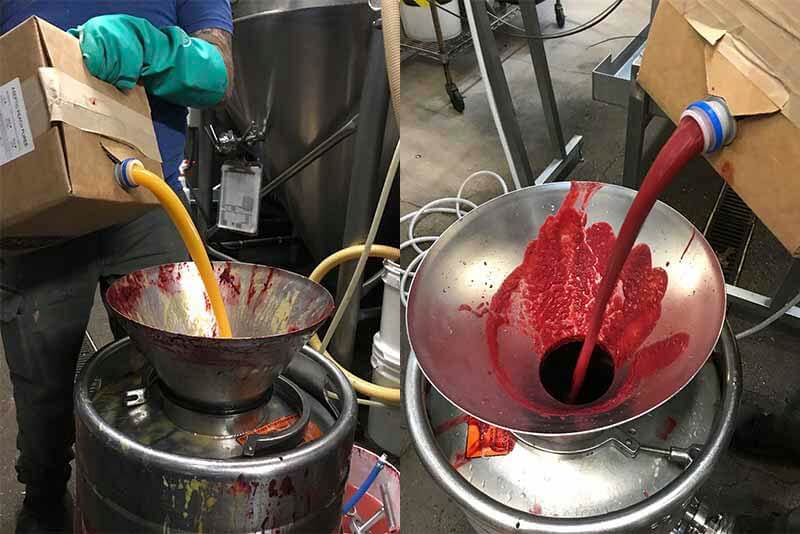
Photography courtesy of Oakshire Brewing
The Cost of Fruit
There are no two ways around it: Fruit is expensive.
Russo says it wasn’t uncommon when they first started making these smoothie beers, with forty to fifty percent of the beer made up of fruit, to spend upwards of $2,000 to $4,000 just on fruit.
That sticker shock may turn you off from brewing a smoothie beer right there. But if you’re still interested in moving forward, you need to consider how you can make smoothie beers while still hitting your margins.
First and foremost that probably starts with making decisions about the fruit itself.
“We’ll adjust our fruits, the amount of fruits, and the combinations to hit a costing parameter that also allows for creativity with the style,” says Russo.
But you could also price your packaged and draft pours of smoothie beers a little higher.
At Oakshire, Theme From the Bottom smoothie beers typically retail for $22/4-pack. While at Mortalis they reach up to $25/4-pack.
And if you’re worried that a higher-priced option might deter folks…
“The cool part is that hasn’t really stopped the hardcore lovers of the style at that price point from enjoying the beer,” says Russo. “I think in a way it is actually a badge of honor, much like $24 4-packs of triple hazies, for us we do it to ensure that we can pay the bills.”
You Have Fruit, Do You Also Need Lactose?
That’s up to you, but Russo cautions that you probably don’t need it because you already have a lot of natural sweetness coming from the fruit.
While lactose adds great sweetness and creaminess to something like a milk stout, in a smoothie beer it often tips the scales too far.
“Especially with the smoothies, there is so much residual sugar from the massive fruit load, it feels excessive to use extra sugar,” writes Russo in a piece for The New School. “We manipulate our OG and FG with our fermentation profile to build the finishing gravity that we desire in our hazies, pastry stouts, and smoothie sours…… We also already use real marshmallow, which sounds and tastes better in the beer than using milk sugar, so we just keep it out!”
The Seven Steps to Brewing a Smoothie Beer
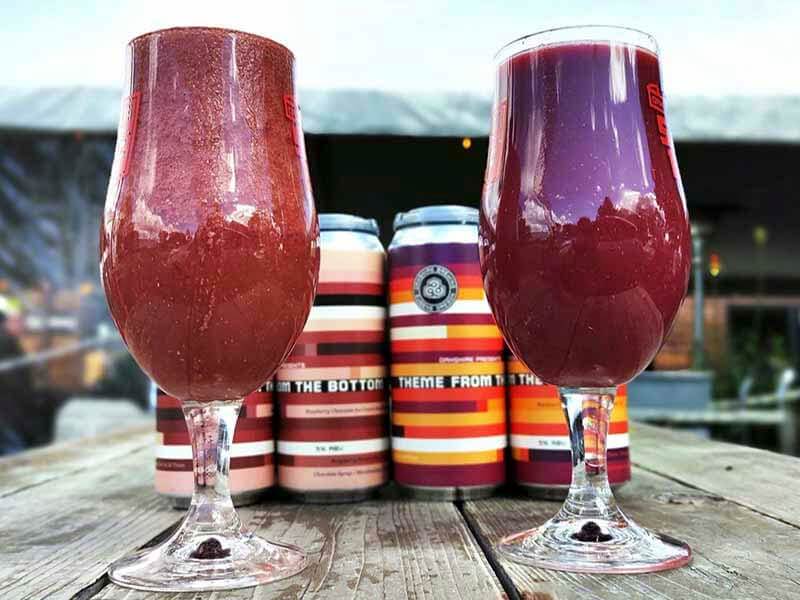
Photography courtesy of Oakshire Brewing
Keep these steps in mind when brewing a smoothie beer.
Malt
With smoothie beers the fruits should be at the forefront, meaning Grenier recommends sticking to lighter grains such as pilsner or two-row malt.
“Generally speaking we want the fruit to be the star of the show, so we’re not looking for a malt base that will impact a lot of flavor,” says Grenier, recommending a nice pilsner or two-row malt, or something really simple.
Depending on the recipe, for example if they’re going down the dessert road, Grenier might add something like biscuit malt to enhance the bread flavor. Or even Maris Otter for those “cracker vibes, especially if we’re going for a pie-fruited sour,” he says.
But other than that, he recommends sticking to the very light, basic malts.
Lastly, since Mortalis brews on a very small 5-bbl system, Grenier also adds a touch of dextrose to his grist. “This is based on the system each brewery is working on, but for us being on such a small 5-bbl, we had to learn how to compensate for that reduced mash tun volume by using dextrose as a partial grain substitution to be able to hit those high gravity numbers,” he says.
For Oakshire, they actually took one of their successful hazy IPA recipes, building a base of two-row, wheat, and oats to create “a body of a beer that will have some thickness,” says Russo. Oakshire wanted its base to stand up to the sourness and tartness of these smoothie beers while also having the characteristic of a classic sour beer.
“[We] throw in oats to really round out that chewy, full mouthfeel that I describe as pillowy,” says Russo. “It’s super soft, but chewy and full, and that will end up combining with the fruit and make this awesome full beer that just reminds you of a smoothie.”
Here’s a peek at Oakshire’s standard grist bill for a smoothie beer:
- 2-Row - 55%
- Malted White Wheat - 14%
- Carafoam or Dextrin Malt - 7%
- Acidulated Malt - 3%
- Rolled Oats - 12%
- Dextrose (Boil) - 9%
Russo says the addition of Carafoam is a trick they picked up along the way, creating a thick, smoothie-puree-like head that sticks around for five to ten minutes even after you start drinking.
With this type of grist bill and a goal of hitting a 9.5%-10.25% ABV, Russo recommends mashing in at lower temperatures—somewhere between 148-149 degrees Fahrenheit.
Mostly because they started to find that their California Ale yeast had a really hard time working its way through this fermentation profile, often coming in under attenuated and taking three or four times longer to ferment.
“We realized the best way to work through the pH drop as well as the ABV was to mash as low as we can,” says Russo.
You’ll figure out what works best for you through your own experimentation, but if you’re looking for a good place to start, “anyone that has their favorite hazy IPA recipe, give that a go as a base,” says Russo.
Hops
Hops aren’t really a consideration in smoothie beers.
Russo actually admits that he uses none at all in Oakshire’s iterations. “I didn’t see a reason to [use] it at all… If we’re going to mask them, it’s just more added dollars that aren’t really doing anything.”
If you for some reason feel that immutable pull (or because technically and legally you need at least some hops in your recipe to call it a beer), Russo suggests using no more than a pound of hops.
And definitely don’t add any on the backend. Think of your approach like you’re making a classic lager. “I wouldn’t go for any more than 10-15 IBUs,” says Russo. Even just that little bit of extra bitterness could end up clashing with fruits that have natural bitterness such as grapefruit.

Photography courtesy of Mortalis Brewing Company
Souring
Just like with the rest of the considerations around brewing smoothie sours, there are plenty of different ways you can sour your beer.
“Are you going to go the lactic acid route, which is very safe?” says Grenier. “You can sour beer, ferment it, and use lactic acid to sour it down, but lactic acid lacks dimensions if you’re going for something more complex.”
At Mortalis, Grenier favors kettle souring because “it’s not quite as safe as something like lactic acid, but sometimes it can be worth the risk if you’re going for that more complex flavor profile.
Russo actually has what is referred to as a Lactobacillus Reaction Vessel, basically a tank that has housed their own sour culture since 2016.
You can add any natural probiotic yogurt with a bunch of lacto cultures to sour beer, but Oakshire works with a local purveyor called Nancy’s Yogurt. In the beginning, they simply bought tubs when they needed them and threw them in, but that resulted in wild inconsistencies in pH and time.
“We learned from some friends in the industry that you can pull off that raw sour wort before it’s ever boiled and store it,” says Russo, explaining that for the next year they kept cans of that culture in their break room at an ambient 65-70 degrees Fahrenheit. This tactic led to smoothie sours with a consistent pH and souring time.
Eventually outgrowing that method, Oakshire bought that lacto-reaction vessel. “We put the culture into the tank and it has been there ever since,” says Russo. It’s never come out; I’ve never opened the tank besides when we sour; it just lives in the cone. I don’t know what it looks like inside; I’m terrified, but the souring process comes out great.”
Now, Oakshire has their souring almost dialed down to a predictable science.
Russo knocks out into the souring tank between 120-130 degrees Fahrenheit because he says the lacto gets going pretty quickly in that temperature range.
He lets the beer sour for between eighteen to twenty-four hours.
“We know in the twenty-two- to twenty-four-hour window we can come in, get that beer into a sour tank, come back the next morning, pull it out of the tank, and start boiling that we will be exactly where we want to be,” says Russo.
Again, Russo is looking for this beer to hit somewhere between 3.4.-3.5 pH. He says they’re lucky that they’ve come to understand their yeast so intimately. For other brewers using a lacto culture, he recommends just monitoring it over time and being ready to move on to boiling whenever you get into that desired pH range.
After reaching that sour range, the beer gets another forty-minute boil before moving on to fermentation.
Fermentation
With fermentation you want to keep in mind again that fruit is the star. For that reason, Mortalis often uses a very clean yeast like a US-05 in its smoothie beers. “Something super clean that won’t give off flavors because you want that fruit to be the star of the show,” says Grenier.
Like we mentioned earlier, Oakshire uses a California Ale yeast during fermentation because it does the best job of eating through those fermentable sugars to get the desired gravity and pH in their smoothie beers.
Russo calls their fermentation pretty normal, taking place in the 67- to 70-degree Fahrenheit range.
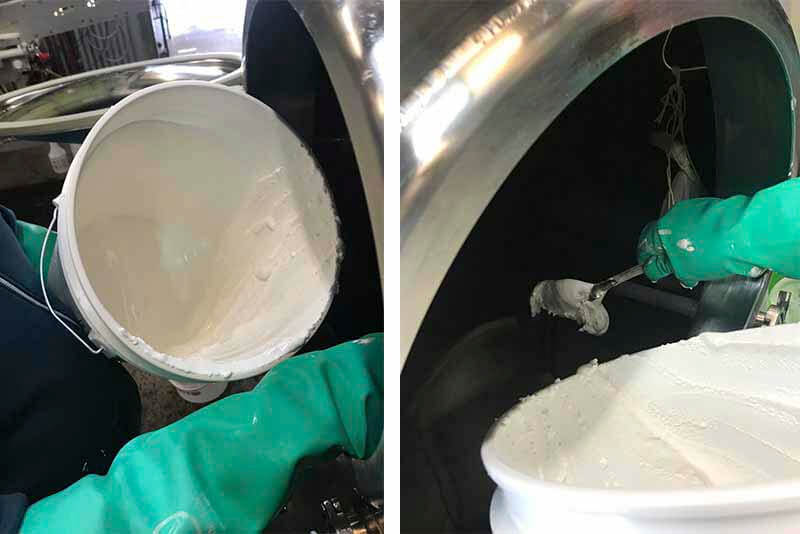
Photography courtesy of Oakshire Brewing
Secondary Fermentation (If Necessary)
Whether you do a secondary fermentation depends on what you’re trying to achieve.
At Mortalis, they don’t do a secondary fermentation before adding the fruit.
At Oakshire, this step helps with two things.
First, the fruitless base beer has time to sit with the adjuncts they add such as marshmallow creme and vanilla beans to pick up more flavor.
Second, because Oakshire only conditions and carbonates with fruit for about one day that’s not a ton of time for their extra adjuncts to impart flavor on the final beer. A secondary fermentation step simply helps bolster the flavor.
At around the two-week mark of fermentation, they don’t cold crash or cool the beer, they just add the adjuncts and let that sit for another five days.
Normally, a Theme From the Bottom smoothie beer gets around 3 lbs of vanilla beans and 100 lbs of marshmallow creme per 14-barrel batch.
Afterwards, Russo crashes the beer and transfers it again to the brite, where he adds the fruit.
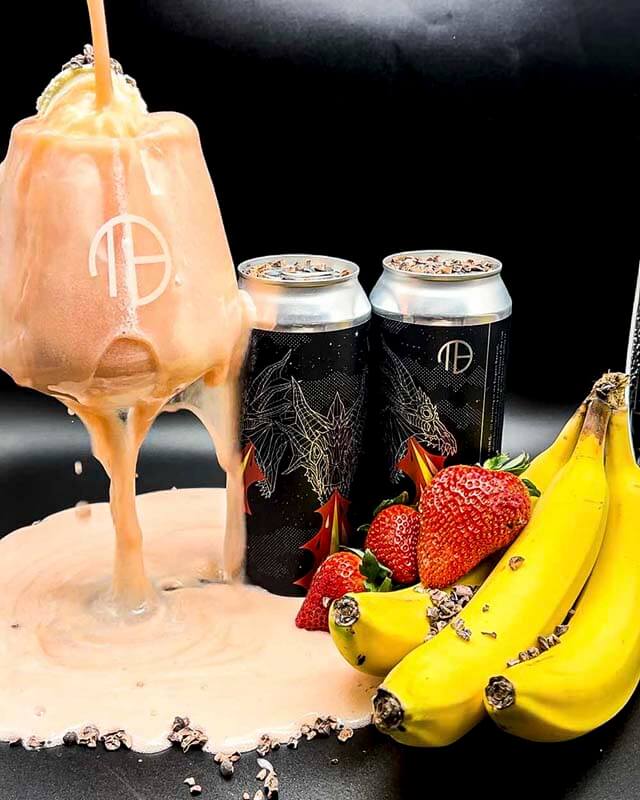
Photography courtesy of Mortalis Brewing Company
Adding the Fruit
How you add your fruit to the finished beer depends on the size of your batch and equipment.
In the beginning, Russo says they would physically pour the fruit into the tank.
Nowadays, they’re adding drums worth of fruit, approximately forty percent of the finished volume of beer (about 6-6.5 barrels, or 1500-1700 lbs), so Oakshire uses a brink with CO2 under a closed system.
Russo finds it easiest to transfer the beer onto the fruit before pushing the fruit up and mixing everything through recirculation.
Carbonating and Recirculating
This is a crucial last step.
“The fruit is so heavy that it will settle and you get stratification in the tank,” says Russo, who hooks up a variable drive pump out of the port on the bottom and back through the racking arm stuck up at a 45-degree angle that they can turn on at low speed. “Once we get it going we are actually recirculating the entire time we carbonate; you’re getting a uniform carbonation and uniform fruit all the way through.”
After that, all that’s left to do is package the beer.
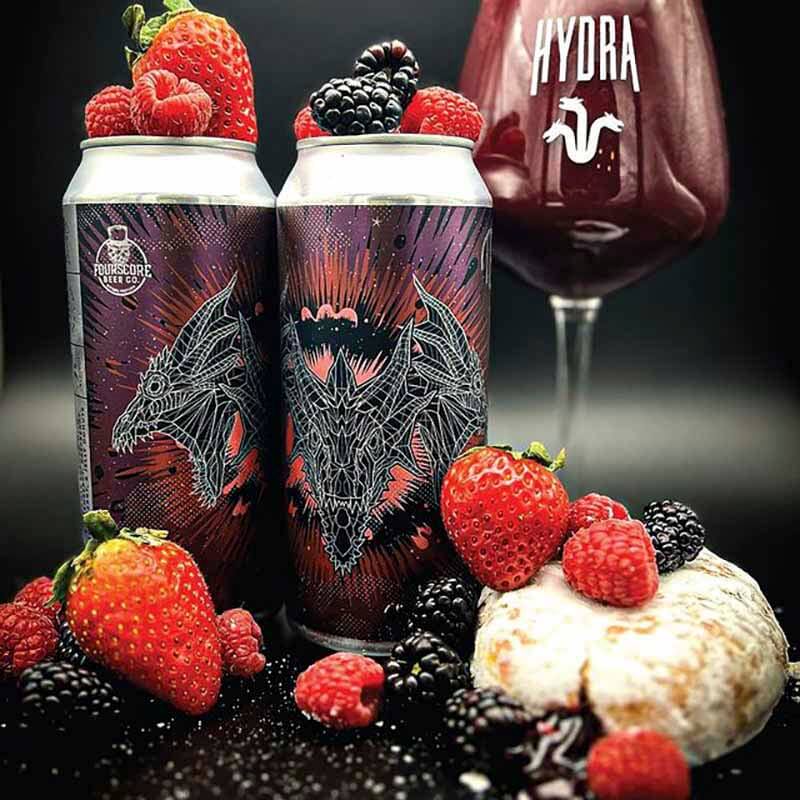
Photography courtesy of Mortalis Brewing Company
How to Package a Smoothie Beer
For Oakshire’s Theme From the Bottom series, they package into 16oz cans.
According to Russo, they’ll recirculate one more time before packaging.
During the actual process Oakshire tends to overfill their cans because “breakout is immensely slow with how thick the beer is, so FOB (Foam-On-Beer, a packaging term for the protective layer of beer foam that forms at the top of the can and helps to reduce oxidation) can be a pain,” writes Russo in an article for The New School.
He also notes they’ll check cans every twenty cases to ensure the carbonation and quality are intact.
What to Know About Exploding Smoothie Beers and How to Prevent Them With a Centrifuge or Pasteurization
One of the biggest hurdles you’ll run into if you are packaging smoothie beers is the potential for exploding cans. Because of the amount of fruit often used in these types of beers, fermentation can continue in a can if proper steps aren’t taken. That additional fermentation could potentially lead to a variety of issues from cans completely popping their top to just foaming over when cracked.
Mortalis experienced this first hand with the very first smoothie beer they brewed, a double mango vanilla.
“We had some exploding cans for sure back in the day,” says Grenier. “We thought we did everything right—like extended cold crashing, filtering to get the yeast out—but it didn’t work quite so well.”
To address this challenge at Mortalis, Grenier buckled down and learned the best ways to package smoothie beers. “It takes a lot more than just wishful thinking, filtering, and extended cold crashing to get those packaged [cans] to a stable level,” he says.

An example of an Alfa Laval centrifuge | Photography courtesy of Grace Weitz
Invest in a Centrifuge
Which is exactly why Grenier took an extra step, investing in a centrifuge.
“The centrifuge basically removes ninety-nine percent of anything that is fermentable,” says Grenier. “After the beer has finished, we’ll cold crash and dump as much of the yeast as we can before we start the centrifuge.”
He notes that he’s seen other breweries run the finished beer through a pasteurization process, but at Mortalis they’ve found a centrifuge to work best.
Invest in Pasteurization
At Oakshire, Russo says they actually invested in a piece of pasteurization equipment after they went through an entire voluntary recall when their Theme From the Bottom – Mango Raspberry Cheesecake started exploding in refrigerators.
Like really exploding. “I remember the ones where people popped the can open and the beer would erupt out of the top like a volcano,” recalls Russo.
After that incident, Oakshire bought a batch pasteurizer.
Pasteurization will essentially kill any of those lingering fermentables in your final beer. “Its easiest form is basically stabilizing the base beer or the beer in general,” says Russo.
A pasteurizer heats beer in various ways to get the liquid above 140 degrees for a certain amount of time, killing off any remaining brewers yeast. “It’s mainly about destabilizing as much of if not all of the brewers yeast [that] is still in suspension to ensure the beer won’t re-ferment,” says Russo.
There are a few different techniques out there for pasteurizing beer. There are ones that run beer through a heat exchanger before sending it back to the tank. According to Russo, these machines are both awesome and insanely expensive.
Tunnel pasteurization is another option, taking cans off the packaging line, running them through a conveyor belt, spraying them with hot water, and pulling them back out.
At Oakshire, they use a batch pasteurizer that allows Russo to put four cases of packaged beer on a rack at time and essentially uses a “water bath that recirculates, sprayballs, and heats up the cans over the course of whatever time you choose.”
Still, if you’re new to the smoothie beer game or even a seasoned pro, you can bet that at some point you might find yourself dealing with exploding cans.
The Way to Handle Exploding Cans
Your response will be the most important consideration while working through this type of hurdle.
To ensure their high-quality standards, Oakshire immediately sent out an email to anyone who had purchased the Theme From the Bottom – Mango Raspberry Cheesecake, automatically refunding them and offering to replace any 4-packs that people brought back to the brewery.
Russo says the honesty and a bit of humor ended up resonating really well with their fans. “When we did ours the disclaimer was to put on gloves and a mask, put it in a bag, put it in your trash can, and run away as quickly as possible,” laughs Russo, noting that in all seriousness though, “just have a response and make sure you stick to that response all the way through.”
With smoothie beers, exploding cans are sort of the nature of the beast. Especially if you’re just starting out in the game, you’ll probably run into this challenge.
“Number one is the customer service,” says Grenier. “You’ve got to address the issue. You can’t look away from or try to avoid it… You have to be transparent, treat everybody right, make things right with your customer base. This is super important to maintain that integrity because [your customers] are the most important thing; that’s it, period. The beer is very important but not as important as the customers.”
Grenier says Mortalis issued an apology post and transparently offered anyone that received an exploding batch of cans to come to the taproom to replace them free of charge.
Educate Consumers to Keep the Beer Cold
Mortalis also started updating the language on their cans of smoothie sours to explicitly say: Drink fresh and keep cold.
“It’s your first line of defense in keeping the product really good,” says Grenier. “Please put that on your cans.”
You can’t just assume that everyone who is buying your packaged smoothie beers understands that you need to keep them refrigerated.
Grenier says with their batch of exploding cans they learned that some people had stored them on their hot porch in the middle of summer. And while, as brewers, you know that this can ultimately lead to that refermentation, you can’t assume that all of your fans understand this scientific process as well.
“You can’t expect them to know this knowledge especially if they’re just getting into the craft beer game,” says Grenier. “They may have tried a smoothie on draft or in a can a friend gave them and got hooked… They could be younger or older folks who are not in the craft beer scene, so it’s better to cover your bases and be approachable to that new craft beer drinker.”
Having language on your cans that effectively tells people how to store and treat the beer is an essential and easy first step in preventing exploding cans.
Two Examples of Successful Smoothie Beers
These are a couple examples of some very successful smoothie beers.

Photography courtesy of Mortalis Brewing Company
Medusa – Mortalis Brewing Company
One of Grenier’s favorites, Medusa started out as a Berliner weiss before veering into the smoothie beer territory.
Passion fruit and dragon fruit are the stars in this beer.
“Such a winning combo, but we had to figure out how to get our pH right because that passion fruit is one of the wildest, tartest elements on the planet,” says Grenier, noting the final beer hit a 3.2 pH.
That meant starting with a very clean grain bill of two-row malt and some dextrose along with just a touch of Liberty hops (maybe just a pound, according to Grenier) at the beginning of a sixty-minute boil.
And fermenting with a very clean US-05 yeast.
“We’re not looking to attain crazy high numbers when it comes to gravity for Medusa,” says Grenier. “The finishing gravity is around fiveish, so we’ll go into fermenting looking to hit around 8-9% ABV.”
After fermentation, Grenier runs everything through the centrifuge before adding the passion fruit and dragon fruit.
Theme From the Bottom – Raspberry Chocolate Ice Cream – Oakshire Brewing
This is Russo’s favorite smoothie sour he’s brewed. Based on an ice cream flavor, Theme From the Bottom – Raspberry Chocolate Ice Cream leverages Oakshire’s aforementioned smoothie beer grist bill, the same souring process, and the adjunct addition of marshmallow and vanilla beans.
But here it deviates, getting an extra dose of powdered vanilla soft serve.
Russo had to puzzle this one out, but he eventually discovered that the mix dissolved easily in warm water. So he waited until they were transferring with the fruit already in the tank to slowly add the dissolved ice cream mix in the brink with just a little warm water.
“When we started to add it all of a sudden you could see the beer getting thicker,” says Russo. “It was awesome to see that happening.”
Today, Russo has switched to using an Oatly Plant-Based Soft Serve mix that comes in liquid form. “We’re taking half gallons of Oatly, pouring them into the brink, and pushing them in during circulation,” says Russo. “It’s cool because you get the characteristics that come across as a melted ice cream bar—it’s pretty wild.”
And after all, isn’t that the unlimited beauty of these smoothie beers?
A Final Piece of Advice on Smoothie Beers
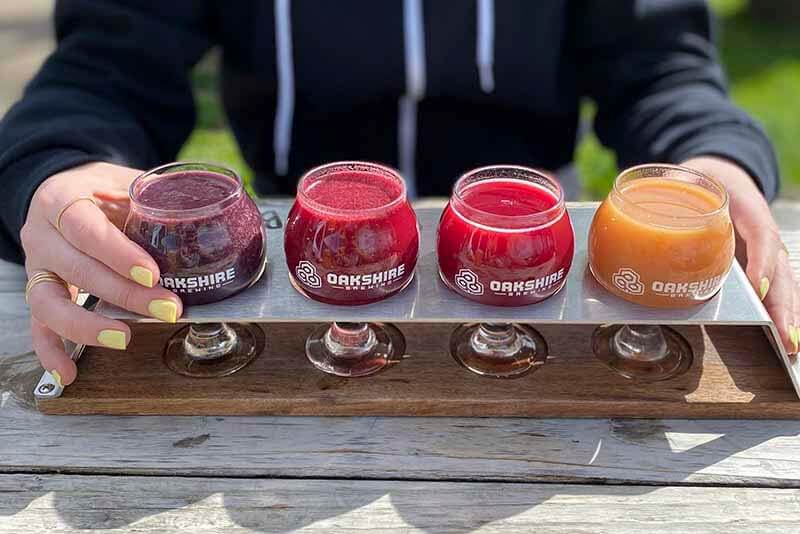
Photography courtesy of Oakshire Brewing
“Experiment, experiment, experiment,” says Grenier. “Right around the corner, in the words of Remy, there is a new flavor combination. You could be the one to discover it… When you start putting those flavors together and experimenting, the sky really is the limit.”
And for Grenier that’s the whole point of this wonderful, sometimes whacky industry. “It’s what keeps us passionate, it’s what gets us excited to wake up in the morning,” he says. “To find that new combination, find those flavors people gravitate to.”
Like a banana split or a double mango vanilla.
“You will fail and that’s okay,” says Grenier. “But it’s when you give up looking that it no longer makes sense anymore. Please keep experimenting, keep pushing the envelope because there is always something new around the corner.”
Brew Your Best Smoothie Beer Ollie.
A brewery management tool built by brewers and for brewers. Handle everything in your brewhouse from recipe development to cost management. All with one easy-to-use platform. Request a free demo today.



